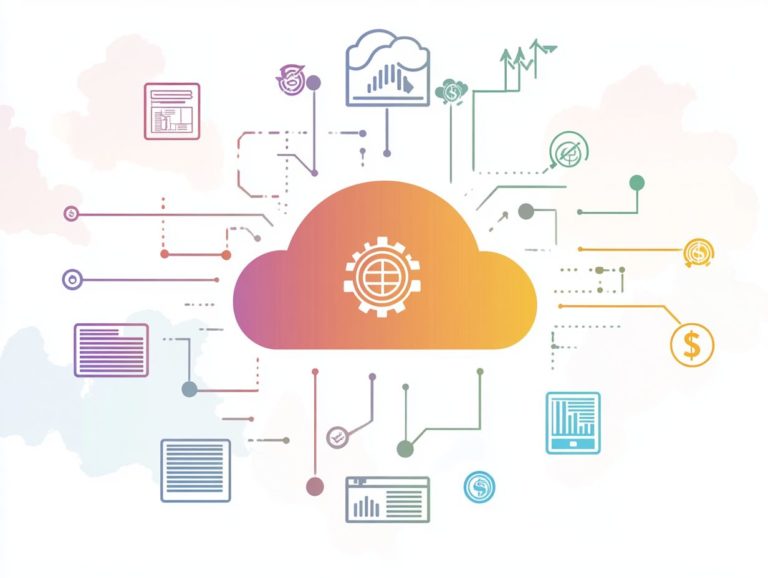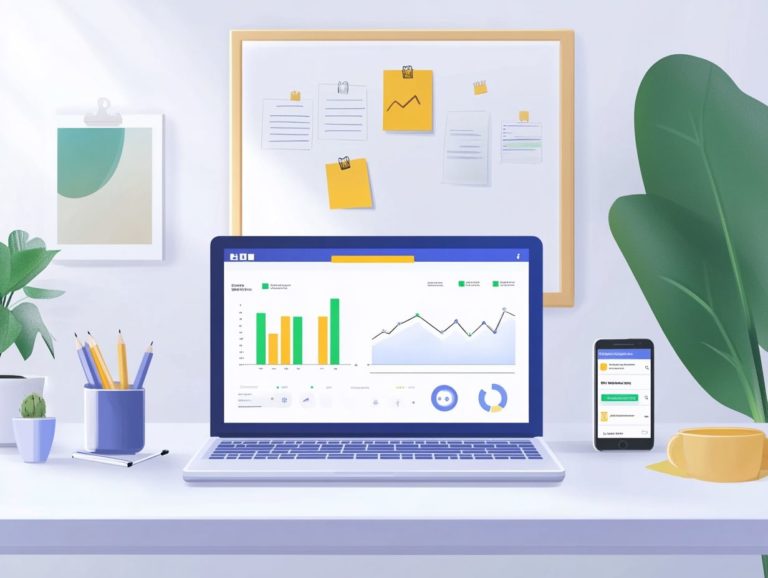How to Evaluate Cloud Pricing Models
In today’s digital landscape, selecting the right cloud pricing model is essential for any business eager to leverage the full potential of cloud computing.
With many options available, navigating these pricing structures can feel overwhelming.
This article breaks down different cloud pricing models and key considerations such as scalability, cost predictability, and the risks of vendor lock-in. We ll also compare offerings from major players like AWS, Azure, and Google Cloud.
By the end of this article, you ll confidently select the best pricing model for your needs and optimize your cloud costs effectively.
Contents
- Key Takeaways:
- Understanding Cloud Pricing Models
- Factors to Consider When Evaluating Pricing Models
- Choosing the Right Pricing Model for Your Business
- Frequently Asked Questions
- What are cloud pricing models?
- Why is it important to evaluate cloud pricing models?
- What are the different types of cloud pricing models?
- How can I determine which cloud pricing model is best for my business?
- What are the drawbacks of a pay-as-you-go pricing model?
- Are there hidden costs in cloud pricing models?
Key Takeaways:

- Choose a cloud pricing model that offers scalability and flexibility to meet your business needs.
- Consider cost predictability when evaluating pricing models to avoid unexpected expenses.
- Be aware of vendor lock-in. Select a pricing model that allows for easy migration to other providers if needed.
Understanding Cloud Pricing Models
Understanding cloud pricing models is essential for businesses seeking to optimize their cloud expenditures and achieve substantial cost savings, which is why understanding the pricing structures of cloud providers is crucial.
These models differ across providers like AWS, Microsoft Azure, and Google Cloud Platform, each presenting distinct pricing structures tailored to various organizational requirements.
Analyze these pricing models to evaluate your cloud infrastructure. For a deeper understanding, consider navigating cloud pricing structures, which helps you make informed choices aligned with your budget and operations.
Choosing the right pricing model can uncover hidden costs and provide insights into understanding SaaS pricing models, ensuring greater flexibility in managing computing resources and workloads.
Overview of Different Pricing Models
Cloud pricing models offer various strategies tailored to meet your unique business needs and enhance cost efficiency. Each model has distinct characteristics for different operational requirements.
For example, on-demand pricing lets you pay only for the resources you actually use. This provides exceptional flexibility but could lead to higher costs during peak usage. Conversely, reserved instances can deliver substantial savings if you can commit to a long-term usage plan, though they often sacrifice necessary flexibility.
Spot pricing offers significant cost reductions for non-critical workloads, but its unpredictability might not align with every organization’s objectives. Understanding volume discounts can uncover valuable savings opportunities.
A solid grasp of total cost of ownership enables you to evaluate long-term expenses against short-term savings, helping you select the model that best matches your market demands.
Factors to Consider When Evaluating Pricing Models
When evaluating cloud pricing models, consider critical factors like cost predictability, scalability, flexibility, and potential vendor lock-in. For more insights, check out how to evaluate cloud vendors. Each element significantly influences your cloud migration strategy.
Scalability and Flexibility
Scalability and flexibility are essential features of cloud services. They enable you to adjust your compute capacity and resource usage according to fluctuating demands.
Utilizing these models ensures you re only paying for the resources you need, significantly reducing overhead costs.
This adaptability is invaluable during peak times when resource requirements surge, allowing for seamless transitions without compromising performance.
Implementing elastic storage solutions helps manage your data storage needs dynamically, enabling you to increase or decrease capacity based on actual usage patterns.
This not only streamlines operational efficiency but also enhances effective workload management, ensuring that your resources align closely with your business objectives.
Cost Predictability

Cost predictability is essential in cloud pricing models. It helps you manage your cloud expenses effectively through clear budgeting tools and a solid grasp of potential upfront payments.
With various pricing structures like pay-as-you-go, reserved instances, and spot pricing, recognizing how these arrangements influence your financial forecasts is crucial.
Dynamic pricing may offer flexibility, but it can lead to unpredictability in expenses if not closely monitored. To mitigate these risks, consider implementing robust forecasting methods.
Analyze historical usage data and utilize automated budgeting tools. A comprehensive understanding of your resource requirements and demand fluctuations tied to specific applications can enhance your financial stability.
This ensures that your cloud investments align seamlessly with your overall business goals.
Vendor Lock-In
Vendor lock-in poses a significant risk when you adopt cloud services. You may find yourself heavily reliant on a single service provider, impacting your cloud migration strategies and overall flexibility.
This reliance can stifle your innovation and hinder potential savings due to rising costs and limited options.
To navigate these challenges, conduct peer comparisons of various cloud providers. Assess not just pricing models but also the overall ecosystem and support they offer.
By exploring multi-cloud strategies and establishing clear exit plans, you can mitigate the adverse effects of vendor lock-in. Prioritize open standards and portability to maintain control.
This approach boosts cost management and operational agility.
Comparing Pricing Models of Major Cloud Providers
Comparing pricing models of top cloud providers like AWS, Microsoft Azure, and Google Cloud Platform is essential for refining your cloud migration strategy, including understanding how to forecast cloud expenses.
This evaluation allows your organization to achieve optimal operational efficiency and make informed decisions aligned with your business goals.
AWS Pricing Model
AWS’s pricing model presents various options, including on-demand pricing and reserved instances. This enables you to optimize compute capacity and manage data transfer costs with precision.
However, the intricacies of this model can catch you off guard, especially if you overlook fees for transferring data out of AWS and storage fees that can escalate rapidly.
By exploring ways to use resources efficiently, you can better forecast your needs and make informed decisions regarding resource allocation.
Monitoring your usage patterns and employing rightsizing techniques can help minimize waste. This turns what could be a chaotic spending spree into a well-structured investment.
Using AWS’s pricing calculator reveals potential savings opportunities by simulating various scenarios, ultimately giving you greater control over your cloud expenditures.
Azure Pricing Model
The Microsoft Azure pricing model offers a comprehensive array of cloud services, complete with volume discounts and flexible payment plans. This helps you manage your total cost of ownership effectively.
This model meets various business needs and helps you manage costs. By committing to long-term agreements, you can unlock substantial savings on essential services like virtual machines and storage.
Additionally, clustering your workloads allows you to take advantage of tiered pricing, becoming more favorable as your usage grows. By grasping the intricacies of Azure’s pricing structure, you can strategically plan your cloud consumption.
This ensures seamless service delivery and significantly reduces your overall costs.
Google Cloud Pricing Model

Google Cloud Platform’s pricing model focuses on resource usage and presents innovative options like spot pricing. This approach enables you to save costs while effectively managing customer commitments.
This flexible strategy proves especially advantageous for businesses aiming to optimize cloud spending without sacrificing service quality. Leveraging spot pricing lets you access excess capacity at lower rates. This is an excellent choice for non-critical workloads that can handle some interruptions.
As you navigate managing resources, striking the right balance between on-demand services and reserved capacity becomes essential. This strategic alignment enhances financial efficiency and ensures you meet customer demands without overspending.
Choosing the Right Pricing Model for Your Business
Selecting the ideal pricing model for your business requires a comprehensive evaluation of your organizational needs. This careful consideration ensures that your cloud migration aligns with both your operational strategies and financial objectives.
Assessing Your Business Needs
Assessing your business needs is crucial for selecting the right cloud services and pricing models. This guarantees that your demand forecasting aligns seamlessly with your operational efficiency goals.
Utilizing targeted methodologies such as stakeholder interviews, surveys, and data analysis provides valuable insights into your unique requirements. This thorough assessment identifies specific cloud solutions that support your operational demands and paves the way for scalable growth.
By aligning these needs with reliable demand forecasting, you can allocate resources more efficiently. This reduces waste and enhances productivity. A comprehensive understanding of your short-term and long-term operational goals enables you to adopt cloud services that facilitate smoother workflows and elevate overall performance.
Cost Optimization Strategies
Implementing cost optimization strategies is essential for effectively managing cloud spending and maximizing resource utilization across various pricing models and cloud services.
By leveraging tools like savings plans, you can lock in reduced rates for your compute resources, ensuring your expenses remain predictable. Load balancers also play a key role in distributing workloads efficiently, preventing underutilization of resources.
Strategically employing these solutions minimizes unforeseen costs and enhances operational effectiveness. These measures help align your cloud expenditures with actual usage, achieving a crucial balance between performance and spending that is vital in today s competitive landscape.
Frequently Asked Questions
What are cloud pricing models?

Cloud pricing models refer to the methods used to determine the cost of using cloud services. This includes factors such as the amount of resources used, the duration of usage, and any additional features or support needed.
Why is it important to evaluate cloud pricing models?
Evaluating cloud storage pricing models allows businesses to determine the most cost-effective option for their specific needs. It helps avoid unexpected costs and enables better budget planning.
What are the different types of cloud pricing models?
The main types of cloud pricing models include pay-as-you-go, subscription-based, and spot pricing. Pay-as-you-go charges for the actual amount of resources used, subscription-based offers a fixed price for a set amount of resources, and spot pricing allows bidding on unused cloud resources at a lower cost.
How can I determine which cloud pricing model is best for my business?
To determine the best cloud pricing model for your business, consider your budget, usage patterns, and expected growth. Understanding cloud billing models and comparing different pricing options offered by various cloud service providers is also helpful.
For further information or assistance, feel free to contact us!
What are the drawbacks of a pay-as-you-go pricing model?
The main drawback of a pay-as-you-go pricing model is the risk of unexpected costs. If resource usage exceeds initial estimates, costs can quickly rise due to increased demand or poor resource management.
Many cloud providers are clear about their pricing, but it s crucial to read the fine print. Hidden costs could include charges for transferring data or accessing technical support that s not part of the basic plan.






